Over 50 years of farming with careful soil conservation
Long-time NSW Farmers member Rod Hatty, 79, has been farming Homeleigh for more than 50 years. These days when he’s not on the tractor, he keeps himself limber on the dance floor.
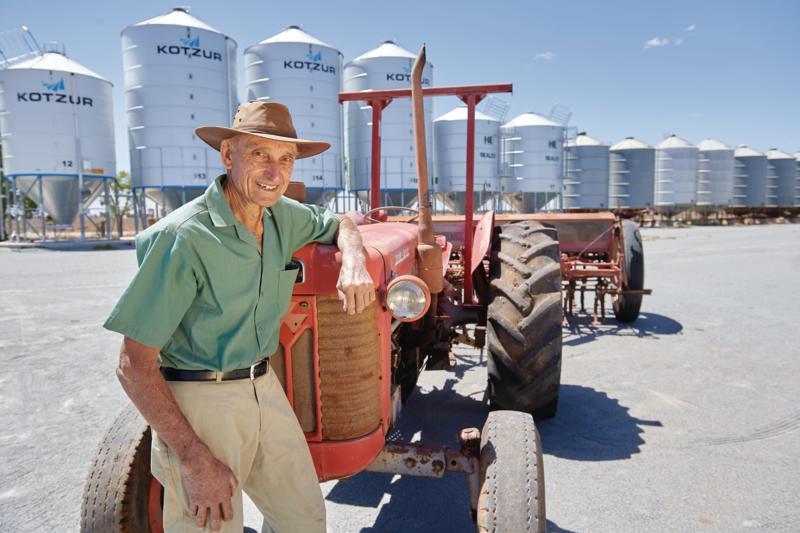 Farmer Rod Hatty with his early 1960s Massey Ferguson 65 and McCormick International combine.
Farmer Rod Hatty with his early 1960s Massey Ferguson 65 and McCormick International combine.
I COME from a long line of Hattys who have farmed in the Ganmain/Matong area of the Riverina since 1905. I moved to an 850-acre [344-hectare] farm in 1965 – I patched up the old homestead, Homeleigh, and I’ve lived here ever since.
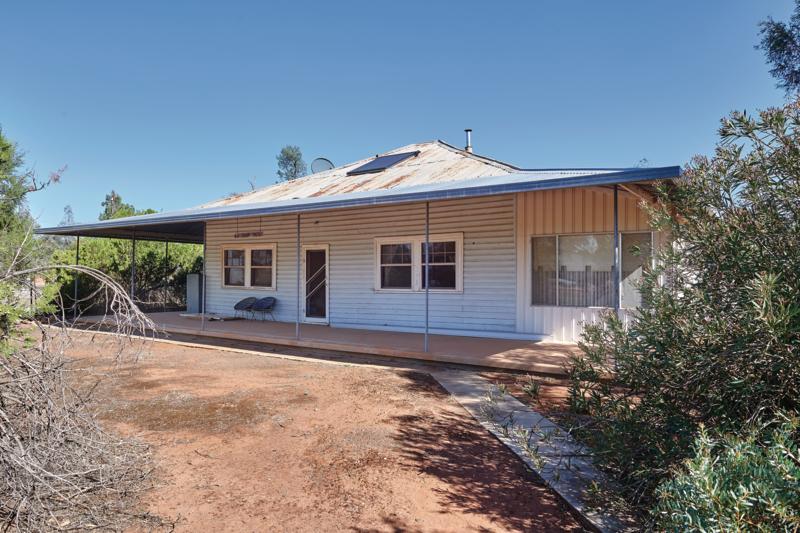 The homestead at Homeleigh.
The homestead at Homeleigh.
Initially I focused on dry area cropping and prime lambs, although we called them fat lambs then, and it was pretty ordinary the way we ran them. It’s a lot more specialised and scientific now. We never thought about fat scores. They were just fat lambs and if they were fat they were good. The price we got from the crossbred wool barely covered the cost of shearing and sometimes we’d wonder if it’d be better if the fleece fell off in the paddock so we didn’t have to bother.
Having said that, we did fairly well, but there were tough times too. Soon after I came out here, it turned very dry. I was hand-feeding the lambs and when an agent reckoned I could get $5 each for them, I took them off to the Grong Grong sales. The best price I was offered was $3.50 so I sold one pen and brought the rest home. They’d sell for near $300 now.
Although I thought sheep were a necessary evil, my son Stephen talked me into getting rid of them and life is a lot easier now. They were 10-20% of our income but 50% of our work.
Many say this drought is the worst they’ve seen, but not having sheep we don’t feel the pressure as much. We’d spent a lot of
money on our dams when we had livestock and with no sheep on them this year, they’ve lasted fairly well.
RELATED: Farmers switch from sheep to cropping
Also, about 15 years ago, when a lot of people were very short of water, a couple of progressive farmers had this idea to run a pipeline from the Bundidgerry Creek. They put a pipe under the channel and a bore down between the channel and the river and I’d say it’s as good as most town water. The pipe runs for about 25 miles [40km] and we all put in money to cover the cost. There’s a bit of cost with maintenance but we needed clean water for spraying and it’s been excellent.
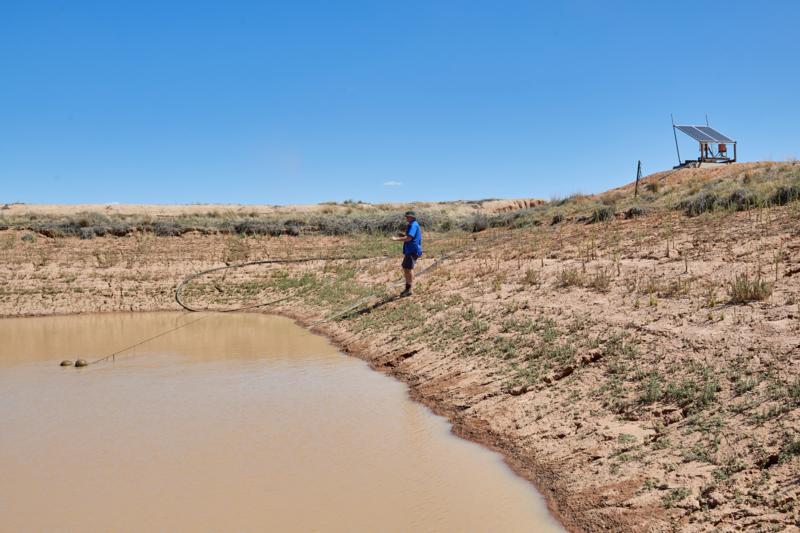 The dam at Homeleigh. Drought has led to the levels getting increasingly lower.
The dam at Homeleigh. Drought has led to the levels getting increasingly lower.
With crops, I initially grew wheat and hay – my dad always said you could get more dollars out of less acres
cutting hay – but as we got more land we dropped the hay out and grew barley instead, which has increased to the point we sometimes wonder if it should be our main crop. It’s in big demand in feedlots.
In 1987, although we were warned it was too dry in our area, we started growing canola and we’ve grown it most years since. We’re also growing faba beans, lentils and peas and it’s surprising how far west peas are growing now.
“I’ve always avoided burning stubble when possible but the big change here has been stubble retention, controlled traffic and no-till farming.”
We went from a spring tine combine, then a spring release combine, then a scari [scarifier] seeder and a couple of years ago we went to an NDF disc harrow. Every time we bought a new machine we’d worry it wouldn’t cover all conditions, so we’ve still got all the old machines dating from the Sixties along with the tractors that suited them!
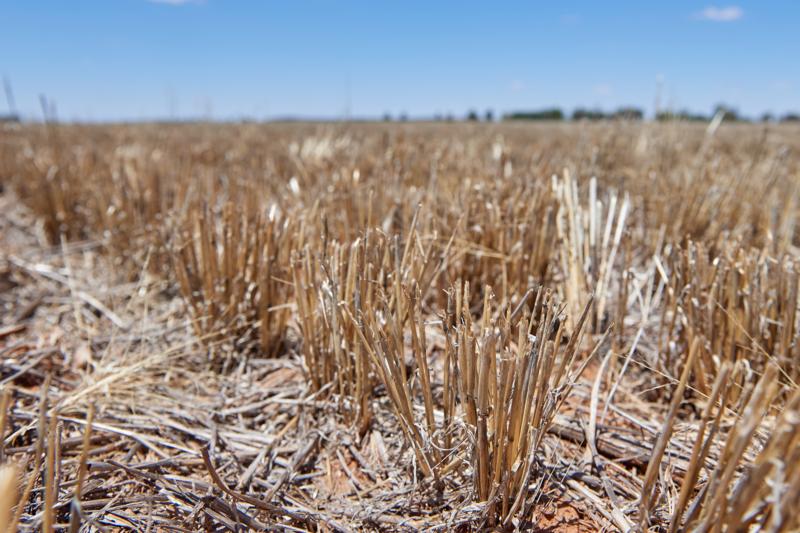 Rod Hatty has always left stubble on their paddocks to protect the soil, even when all the neighbours were burning it off.
Rod Hatty has always left stubble on their paddocks to protect the soil, even when all the neighbours were burning it off.
We’ve also got GPS now and it’s amazing how accurate that is. I’ve been a bit lazy about working out how the computers on the tractors work so if I want to change something I have to ring Stephen and ask him to talk me through it.
One thing that has stayed the same is that I’ve always been a NSW Farmers member. I joined up soon after I left school in 1957. In those days it was the Farmers’ and Settlers’ Association and cost 10 pounds a year. I’ve got a certificate somewhere for 50 years’ continuous membership. I’m up to over 60 now. I was on the Executive Council for 20 years and the Grains Committee for quite a few years as well.
READ ABOUT OTHER NSW FARMERS:
-
Farmers want a bigger say in weed management
-
Reliable telecommunications key for rural communities
-
Poultry in motion: the chicken farmer keen on education
I’m still the chairman of the Ganmain/Coolamon branch and I’d like to see a few more farmers getting active. Without NSW Farmers there would be no-one pushing to get us help from politicians.
If you asked me the best change I’ve seen, I’d say it’s bulk handling. We had to lump 180-pound [82kg] bags of wheat and superphosphate. We had to drag it in from railway trucks then into the shed, out to the truck, and into the combine – and it was always summer when it was 110 degrees in the waterbag. Even hay had to be stooked by hand then stacked by pitchforks. Stooking 1,000 tonnes of hay over summer takes a big effort. We did a lot of hard yakka in those days and a lot of farmers my age are worn out or six-foot under as a result.
I’ve been left with a crook back but the best thing I’ve found for it is old-time dancing. I used to be at the chiropractors every few months but since I’ve started dancing I haven’t needed to go. It’s a lot cheaper – and a lot more enjoyable.
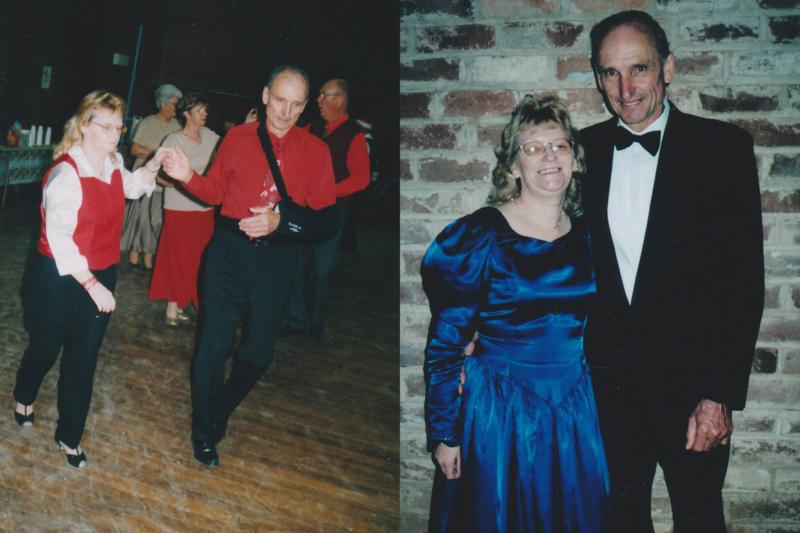 Rod is a keen old-time dancer and says his back is much better for it.
Rod is a keen old-time dancer and says his back is much better for it.
Removing livestock for better soil care
Stephen Hatty, 50, has been on the land all his life and shares his father Rod’s commitment to soil care. The father-of-five says his children are welcome to join the family farm business.
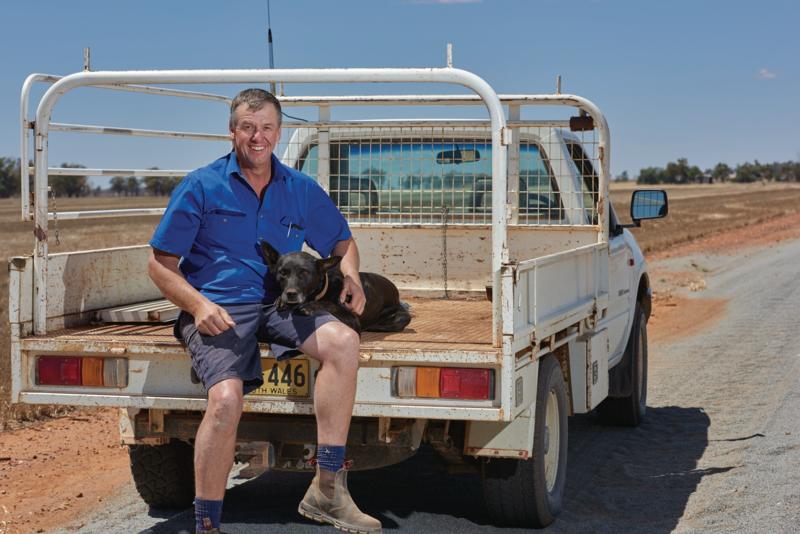 Stephen Hatty with dog Tom.
Stephen Hatty with dog Tom.
I’ve never left this farm. My sister Glenys and I were born here and when I left school in December 1986, I went straight onto the header for harvest. I did an external agricultural course while still working.
I married Michelle in 1992 and we built a new home 400m from Dad’s house. At that stage we were still running sheep , but I don’t like sheep and figured our country is more suited to cropping. Without stock our clay soils don’t seal over and we don’t have the compaction and removal of cover off the soils.
It was a point of discussion with Dad for a while – it began in the mid-Nineties but the last sheep didn’t leave until 2015 – and once they’d gone we had to be more diverse with our cropping system. If we’d only grown wheat, for example we’d have been fully exposed to that market.
We’ve introduced many changes in the past 20 years but the no-till system is the key that’s enabled us to go to the full crop system and give us security. It’s certainly helped pull us through this drought. Last year we had very little rain but were able to use the moisture that fell in December 2017 to grow a crop and break even.
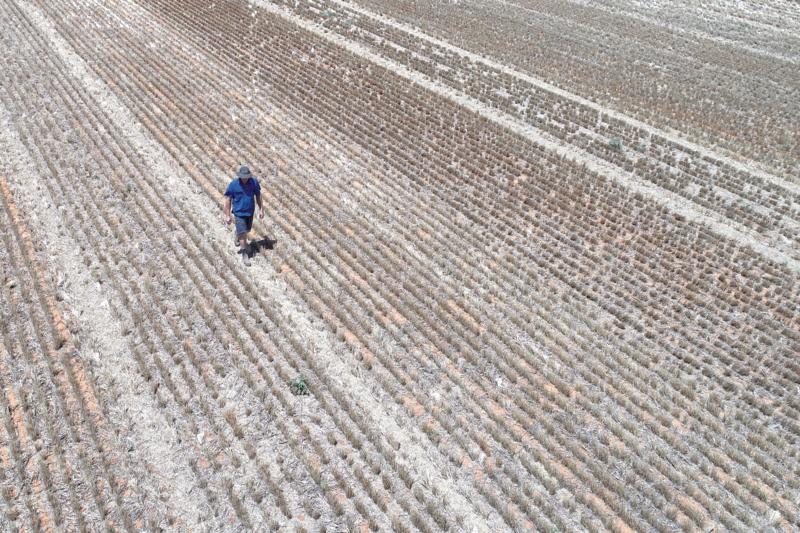 Stephen inspecting one of the stubble paddocks.
Stephen inspecting one of the stubble paddocks.
Dad and I try to make decisions together and he’s been supportive of all the changes. He’s always been interested in maintaining soil health,
keeping nutrients and biomass in the soil rather than burning stubble like our neighbours did. Even in the Seventies and Eighties he was carrying some stubble in the system and had already bought machinery that could handle it.
RELATED: Reaping the rewards of biodynamic farming
I shared his interest and even as a kid I’d see big clouds of dust rise up when people were cultivating and knew that was money going off into the atmosphere in lost nutrients.
“Once the soil is gone as dust, you can’t get it back. It’s always been a bit of a focus to keep it on the ground with stubble protecting it.”
The use of electronics in machinery has been a big change. Monitors help you realise if you’re driving the header too fast and wasting grain. GPS improves the accuracy of placing fertilisers and chemicals and revolutionised savings. It’s also enabled us to plant crops within last year’s stubble rows to retain cover and set up a controlled traffic system. Our agronomist says our soils are a lot softer than those in other places.
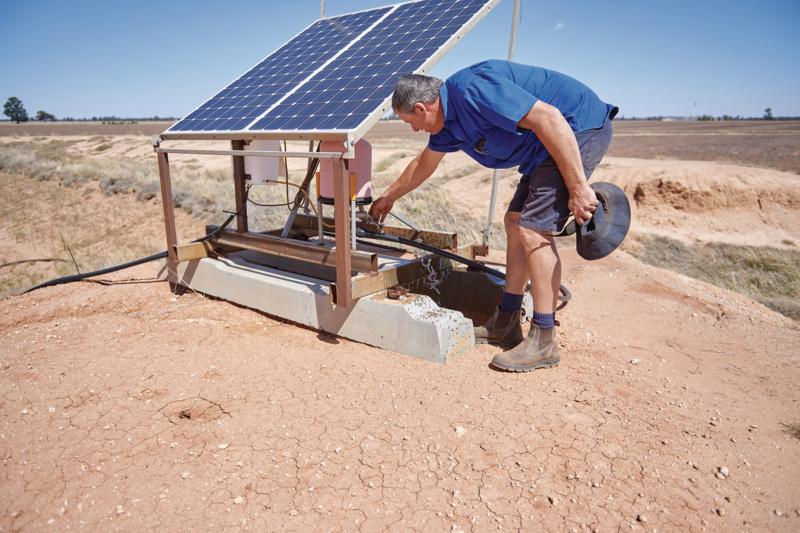 Inspecting the solar-powered pump on the dam.
Inspecting the solar-powered pump on the dam.
Chemical use is another big change. Very few chemicals were used when I left school. The cleanliness of the crops, the way we’ve been able to get on top of a lot of weeds and the husbandry we’ve been able to maintain with our cropping systems are phenomenal.
Physically it’s much easier being a farmer now than it was in Dad’s day but the mental stresses of getting everything set up properly are greater and I think some of the regulatory issues that get thrown at us can cause the most stress of all.
There is so much compliance and a lot of it could be covered with a bit of common sense. I mean if someone can’t see an oversized piece of machinery when it’s 15-feet high and painted red before they see the sign and the little flag on the side of it… come on!
I’ve always been happy for my sons Nathan and Joel to be part of the family farm, but it’s their choice. They can have the opportunity if they so desire and the same for their three sisters, too, when they finish university.
Leader for young farmers keen on agricultural technology
After trying life in the big smoke, Stephen and Michelle’s son Nathan Hatty, 22, decided on a career in farming. Now in his final year of his ag degree, he has big plans for young farmers.
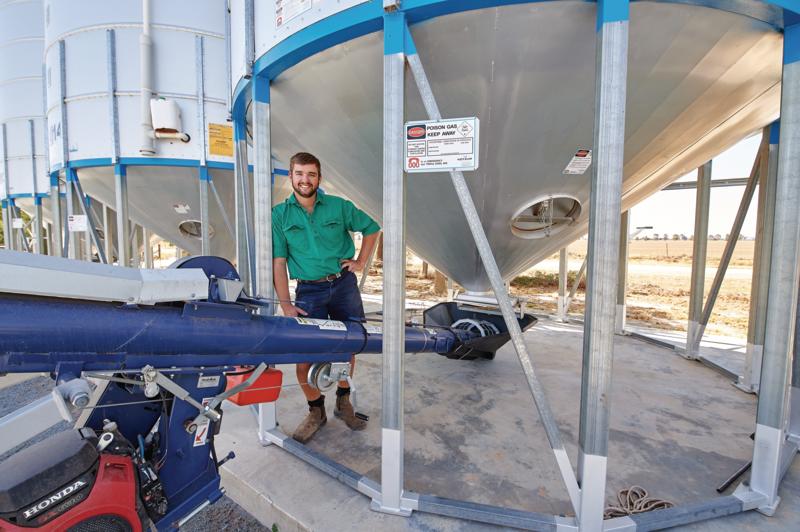 Nathan Hatty under one of the silos at Homeleigh.
Nathan Hatty under one of the silos at Homeleigh.
Growing up, I’d often hang out with Dad. Mum tells a story of me going on the tractor to
plough firebreaks with him while I was still in nappies. I was always helping out with something – whether sowing, harvesting or lamb marking. I always knew I’d come back to the farm although Mum said to go away and look at alternatives first. If the farm went bust she wanted us to have something to fall back on.
When I finished high school in 2014, I went to uni in Wollongong for a year to study mining engineering. I didn’t like the degree or city living – having always been a country boy it was too much of the big smoke for me, so I returned to start an agricultural science degree at Wagga and I’m now in my final year.
When I’ve finished I’ll work in agronomy or farm management for a while then come back here to join my older brother Joel. We have 2,200 hectares on seven blocks, spread in a 20km radius of the home block.
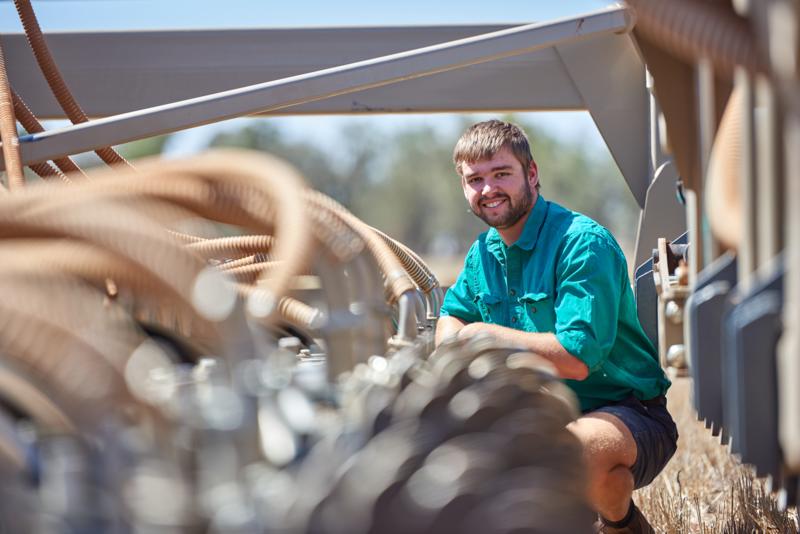
Nathan tinkering with the NDF planter in the stubble paddock.
I still get home to work when I can and have a few ideas on the science side, but Dad’s always been progressive in keeping up with the latest technology and farming practices so we’re not much different in our ways of thinking.
RELATED: Young farmers raise the profile of agriculture
When I went to Wagga in 2016 I joined NSW Farmers’ Young Farmers, and I’m now chair of the Eastern Riverina branch and also Young Farmers’ rep on the Grains Committee. My grandfather has always been heavily involved in the Association so that’s probably the main way I’ve become involved too.
“He wanted a voice to get our views across to a wider public and that’s something that’s important to our family. If our voice isn’t heard we won’t get a fair go."
Since 2016, there are more dedicated Young Farmers’ branches across the state, so we have more of a voice within the Association and get more value out of it, and membership has gone up as a result.
One of the best things we’ve worked on is the
Young Farmer Business Project in conjunction with the NSW Department of Primary Industries, providing workshops on banking knowledge and business structures. Anyone else running a business the size of a farm would have a business degree behind them, whereas farmers are expected to have the science and practical skills plus business expertise.
RELATED ARTICLES ON YOUNG FARMERS:
-
Why is there a shortage of shearers?
-
We’d love to farm – so give us a break
-
The brand smashing the supply chain
I’ve also been working on events in the local area so people can network and I’m on Twitter which is useful for
connecting with more progressive farmers across Australia and the world. There are lots of good ideas floating around with regards to machinery setup and different practices and products.
I think the biggest challenge into the future is drought. I’ve lived through two big droughts and the way people are talking, that’s only going to get worse. However, people in the cities are now aware of what’s going on west of the mountains so hopefully that will influence political decisions a lot more.
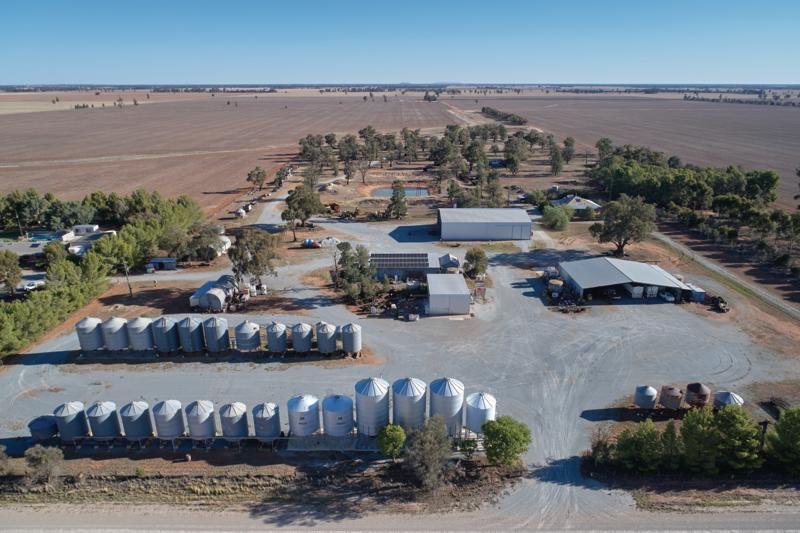 Grain silos and shedding at Homeleigh.
Grain silos and shedding at Homeleigh.
Meanwhile, we have to improve our practices to deal with it. Without minimum till for instance, we wouldn’t even have grown a crop in the past two years and I’m proud of the way we’ve moved to more sustainable farming. It means we’re working towards a farming business that will remain viable.
“I’m proud of the way we’ve moved to more sustainable farming. It means we’re working towards a farming business that will remain viable.”